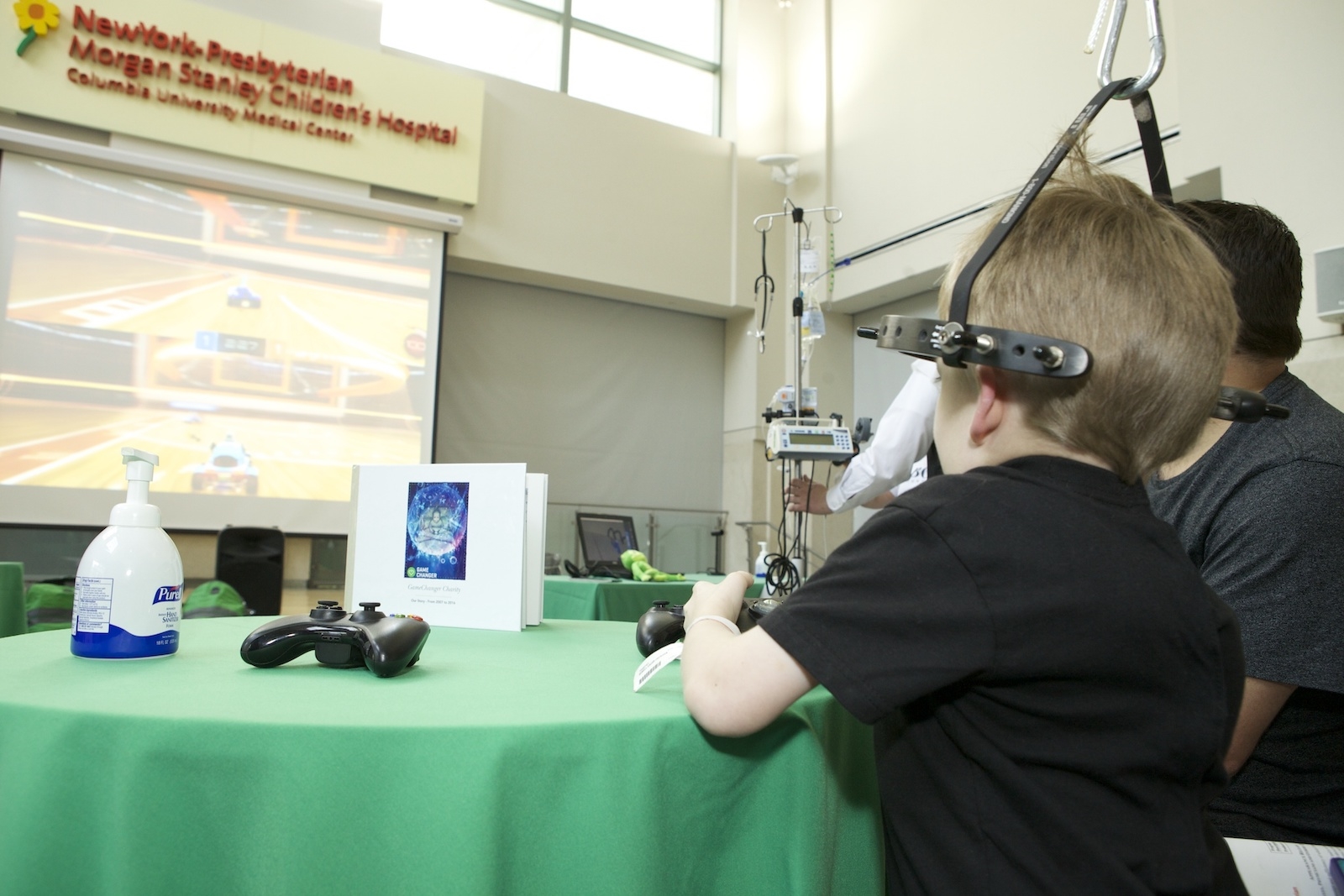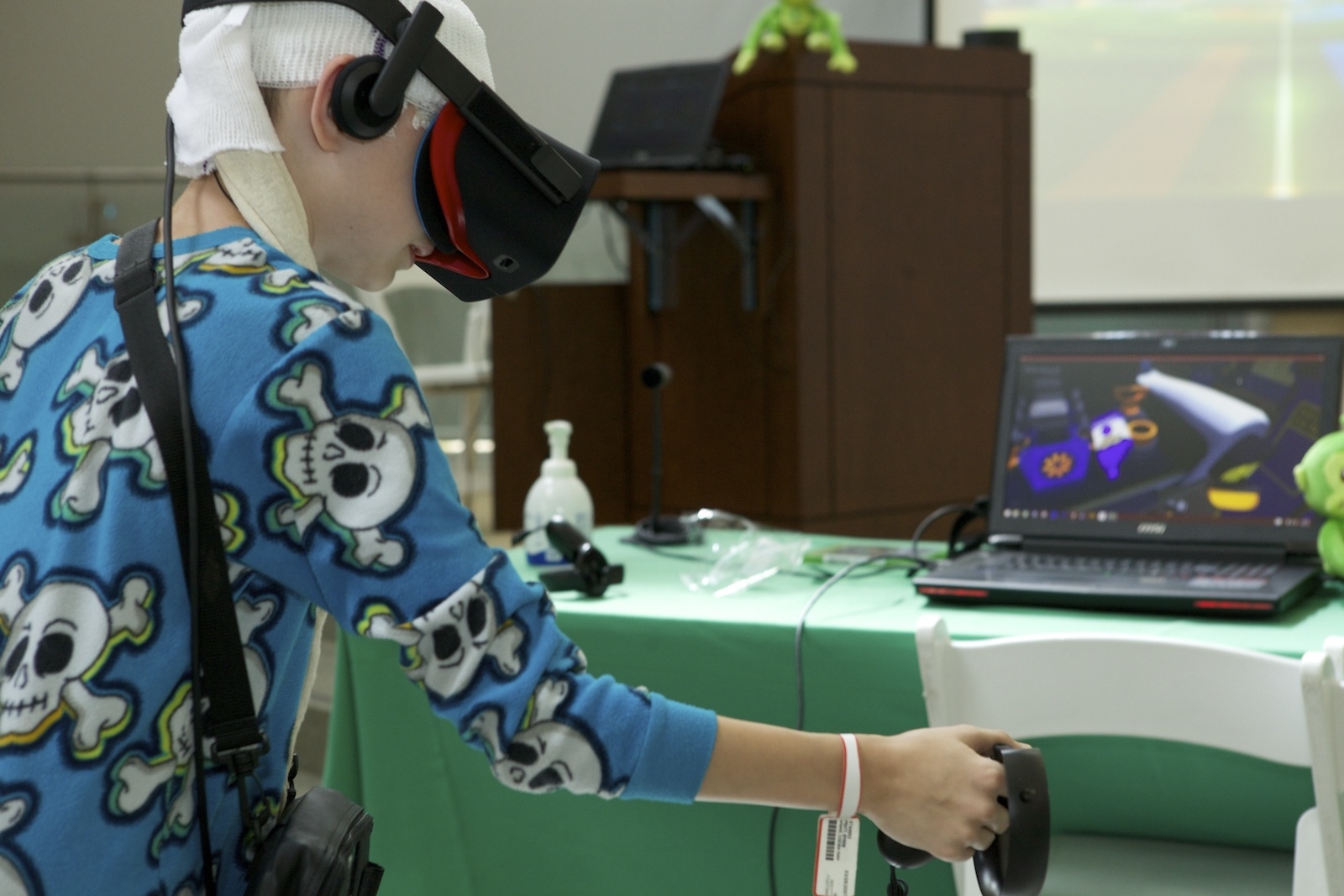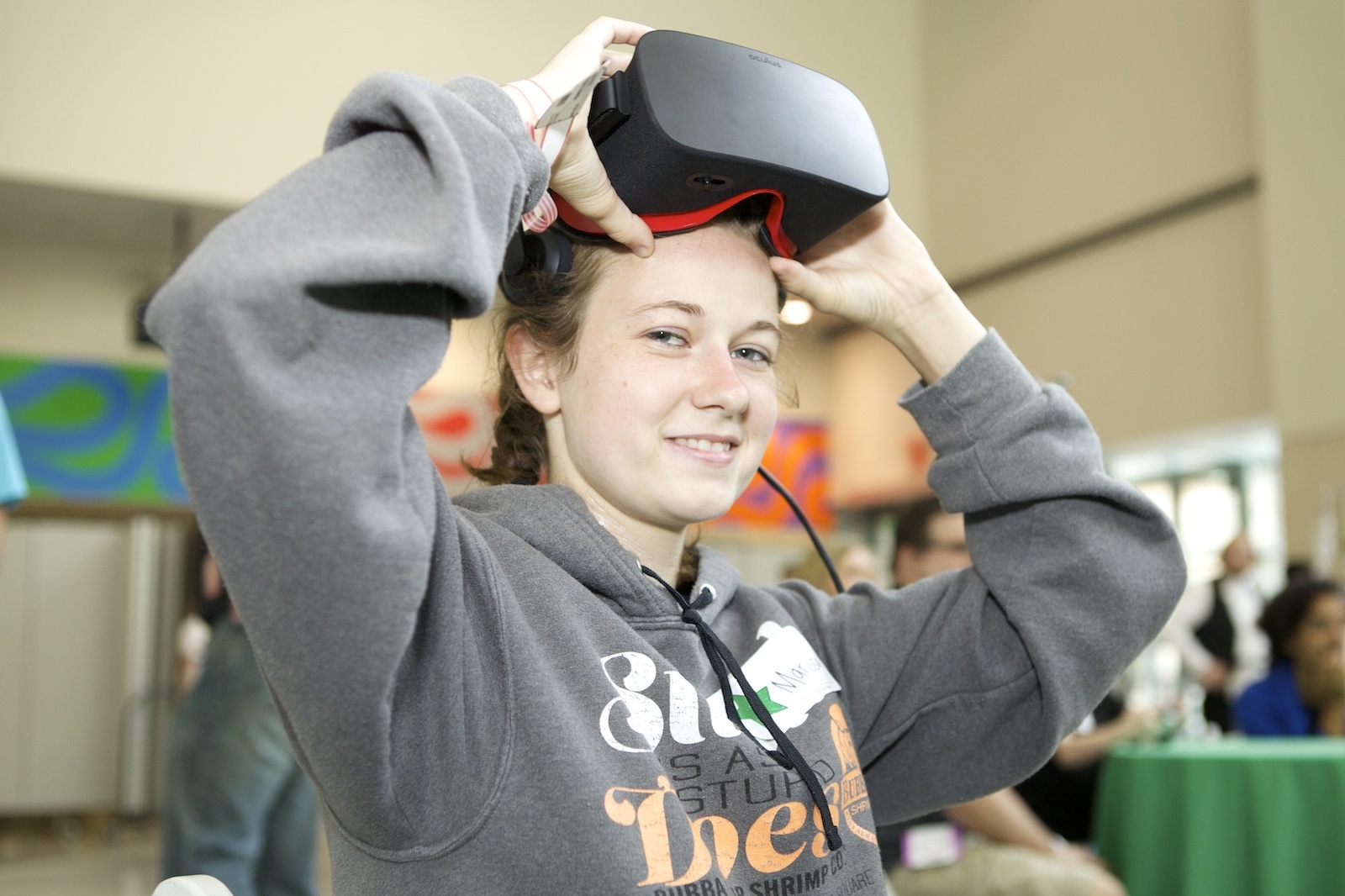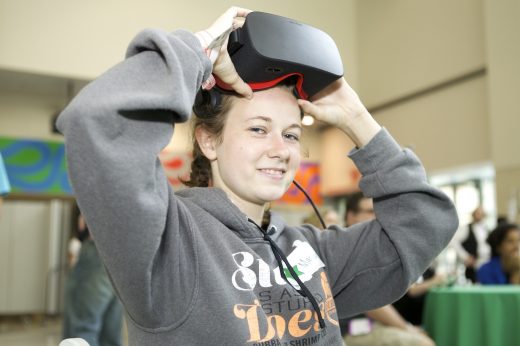GameChanger brings virtual worlds to the kids who need it most
I was standing in a makeshift room at NewYork-Presbyterian Morgan Stanley Children’s Hospital with a couple dozen people. Some of them were young children battling cancer, others were family and friends there to spend time with them. There was a handful of hospital staff. Spread out across the room were a young woman unknowingly about to get a scholarship, a social worker who had paid for a child’s cable bill so that he could have some comfort in his last few weeks of life and team members of a charity who had brought everyone there so that sick children could have a little bit of fun for a few hours. It was an event that was both solemn and uplifting, and it was all centered around video games.
GameChanger came out of that idea, and it really started to ramp up after Taylor left for college in 2013. (He just graduated from Harvard this spring.) At first, the charity was giving around 500 gaming consoles per year to hospitals around the country, but that quickly started to grow once gaming and tech corporations started to get involved. Some of the charity’s partners now include giants like Amazon, Microsoft and Sony, as well as companies like Twitch, Valve and Nintendo. Its board of advisers also has representatives from Valve, Twitch, Unity and others. Popular YouTuber Captain Sparklez is on GameChanger’s board of directors.

GameChanger takes just about anything that companies are willing to give, much of it being items that are just slightly too old for sale and are destined to be destroyed anyway. That includes tablets, gaming consoles, games and even marketing goods. Jim said GameChanger wasn’t allowed to bring tech on a recent trip to Cuba but was able to bring shirts and hats from gaming companies, which the children loved. “We’ll take anything that’s new, that’s excess material that can be repurposed that these families would love to have,” said Jim.
GameChanger has four main programs. The Gamer’s Give Back Tour is held in association with Child’s Play Charity and brings games and a giant meal to around 40 hospitals per year. Two others include a merit-based scholarship program and AR/VR setups that the group installs in hospitals. The fourth program — GameChanger Days — was what took place at NewYork-Presbyterian. The event brings a number of different gaming setups that patients can play, as well as gifts and livestreamers who come and game with the children.
Walking into the event, it wasn’t what I expected. It was quiet, subdued. There were no announcements, no microphones, no pomp. It was a room within a room — an area of the lobby blocked off by tall dividers — with enough space to host a couple dozen people without ever feeling crowded. A bunch of gaming systems were set up around its perimeter — two Oculus Rift stations, three XBox Ones and two PlayStation 4s, one with a Thrustmaster T80 Racing Wheel and a PlayStation VR headset.
Kids were slowly being brought down to the event, each having to be escorted by hospital staff or family, some in wheelchairs, all of them with some sort of medical equipment in tow. But each one immediately jumped into a game. Whether it was Guitar Hero, Driveclub or Rocket League, each kid was quick to pick a station and didn’t hesitate to begin playing, even if it was with equipment they had never been able to use before. And while it often took a little finagling to make sure the IV lines didn’t get tangled with the gaming cords, all of the kids looked like they were having the best time. After just a few minutes of being there, it was easy to see how video games can have the impact that they do. For a couple of hours, these children got to play with brand-new games, and in most cases they got to do so alongside their friends and families.

There were a dad and a son who played round after round of Rocket League together; a mother who had to help her son through a couple of games because he was so small it was hard for him to hold up the guitar to play Guitar Hero or balance with the Oculus Rift headset. One kid used an Oculus Rift setup for a solid 30 minutes before moving on to another station. Stephanie Blanco, the social worker mentioned earlier, told me that she’s seen firsthand how big an impact video games have on the children on her floor. For a little while, “it’s kind of like being home,” she said.
For these sorts of events, GameChanger makes sure everything is taken care of from its end. Having been a part of these types of hospitals for quite some time, Jim and Taylor put in every effort to make sure that the hospital staff isn’t given any extra work. They don’t host events in hospitals during the holidays, because they know so many other charities and organizations do so during that time of the year. And during Gamer’s Give Back Tours, they make sure that the hospital staff give the games to the kids, not GameChanger team members. “We’re just the messengers of the love and compassion and generosity of the gaming and tech communities,” said Jim.
At this event, Jim would also be awarding a scholarship. While sometimes they may be given in front of the group during the event, a look around this particular GameChanger Day led Jim to decide that it should be done more privately, off to the side. He talks about these spaces being sacred and says that he doesn’t want to disrupt any of the fun the children are having. The scholarship was going to a 21-year-old woman with leukemia. To pick an awardee, GameChanger asks the hospital staff who would be a good candidate. No evaluation or application is done; it’s just whoever the staff thinks is deserving.
When the scholarship awardee entered the event with her family, Jim went over and introduced himself. He explained what GameChanger does and how scholarships are decided. He then told her that she was the person the staff thought would be a wonderful candidate, and handed her a check for $2,500, telling her that it could be used however she saw fit — school, books, living expenses. She started to cry, as did her mother and Jim and nearly everyone else in the vicinity. She said that her mother needed the financial help more than she did, so the check would be going to her mom. Jim then said something to her privately, and that was it. A few more hugs all around and everyone went on their way.
Jim told me later that what he whispered to her was that she should keep the money and he would make sure an additional check would go to her mom. He then asked Blanco to find out how much it would take to get the patient’s mom out of a financial hole and said that whatever it was, he would get that amount to her by the end of the day.
Jim cried as he told me this. He cried a number of times as he told me stories about past events, or particular patients, hospital staff that go above and beyond and kids who have been lost along the way. He whispered whenever he mentioned that many of the kids in these types of hospitals are very, very sick, and he said he pays attention to every IV pole a child comes in with, because the more items there are on that pole, the sicker the child is. Jim and Taylor are very passionate about GameChanger. It comes through clearly when they talk about the work — Jim often doing so through tears, Taylor with incredible poise.
This event had one Twitch streamer in attendance — Lindsey Vega — who’s done these sorts of events before. Jim told me that three were scheduled to come but two had dropped out because the gravity of the event made them nervous. Before going to play Rocket League with a couple of attendees, Vega told me that in regard to events like GameChanger Days, “It’s definitely something that needs to be done and needs to be seen.”
During this visit, Jim, Taylor and the rest of the GameChanger team took a look at a room that had originally been built to be a sort of gaming oasis for the kids at the hospital but had fallen out of use and out of supplies over the years. Nadine Ulysse, a child life specialist at the hospital, said that the children really love tech, so it can be disappointing to them when there’s not enough to go around. GameChanger is now going to outfit it with a ton of AR and VR tech and will team up with Child’s Play to provide a staff member who will make sure it all stays running. Again, they don’t want any extra work for the hospital team.
Jim said that working with other charities has been a big part of GameChanger’s work. “We’ve formed a strategic alliance with other like-minded charities, and we just said, ‘If we’re all giving away millions of dollars a year to these kids, let’s do it intelligently so one and one equals three.'” They also work closely with AbleGamers Charity, along with whom they’ve developed voice control gaming systems for kids who can’t play them the traditional way.

After awarding the scholarship, Jim and Taylor slipped out. They had a call scheduled with a group of researchers who are looking into the healing effects AR and VR can have on patients like the ones at this event. With GameChanger-provided tech in 80 US hospitals and 11 countries, Jim and Taylor are kept pretty busy.
The event continued on long after Jim and Taylor had left, with dozens of kids just enjoying the day. As I left, three children were playing Rocket League with someone from GameChanger’s team. Their game ended and it was high fives all around.
Images: NewYork-Presbyterian Hospital / Steven Harris
SaveSaveSaveSave
GameChanger Charity is a group that, in a way, got its start in 2006. Taylor Carol was an 11-year-old living in southern California, son to a tech CEO and part of a family that was heavily involved in sports. One day, he broke his elbow playing baseball, which wasn’t a big deal — until a few weeks later, when doctors noticed his arm wasn’t healing at all. A blood test showed that his white blood cell count was 23 times higher than it should have been, and a diagnosis of leukemia came in short order. “We were lost. We were confused. We were angry,” Taylor told me.
Soon after the diagnosis, the Carols moved to Seattle in hopes that Taylor would be accepted into an experimental treatment program. After he received a bone marrow transplant, Taylor had to be isolated to make sure he didn’t contract any illness while his immune system was depleted and while they waited for the transplant to take. The only people allowed to enter Taylor’s room were doctors and nurses in hazmat suits. It took 21 days for his transplant to engraft, around a week longer than what’s expected, but Taylor still wasn’t out of the woods. Unfortunately, he developed graft-versus-host disease, which is caused by the transplanted bone marrow seeing its new body as foreign and rejecting it. Taylor had to spend six more months in isolation while he fought to stay alive.
During that time, Taylor and his family were looking for any source of stability they could find. “We found that through faith, we found that through friends and, most importantly, we found that through gaming,” he said.
Video games let Taylor escape his quarantined room and provided him with a “little taste of normalcy,” as he said. He could hop onto the hospital phone and brag to his friends about his Crash Bandicoot time or complain about how hard a certain level of Re-Mission was. And he said the effect was the same for other kids in his hospital. Once he was out of isolation and could see other children, he said, “The kids who could play games were so happy.” And, Taylor told me, games were able to create moments between these kids — many of whom were in awkward preteen years — that allowed for conversations about fear, loss, grief and confusion that otherwise were hard to have.
And as his dad, Jim Carol, pointed out, most of the games available were incredibly outdated. They were playing Nintendo 64s in 2012, but it didn’t matter; even old technology allowed for a necessary escape. “That’s how it all started,” said Jim. While Taylor was still in the hospital, he and Jim realized that almost everyone has some old video-gaming equipment sitting around gathering dust. Although at first Jim turned to games in order to help Taylor, he quickly realized that this was something that could be done on a much larger scale.
(33)













